Gear CITROEN C-ELYSÉE 2018 Handbook (in English)
[x] Cancel search | Manufacturer: CITROEN, Model Year: 2018, Model line: C-ELYSÉE, Model: CITROEN C-ELYSÉE 2018Pages: 260, PDF Size: 8.4 MB
Page 5 of 260
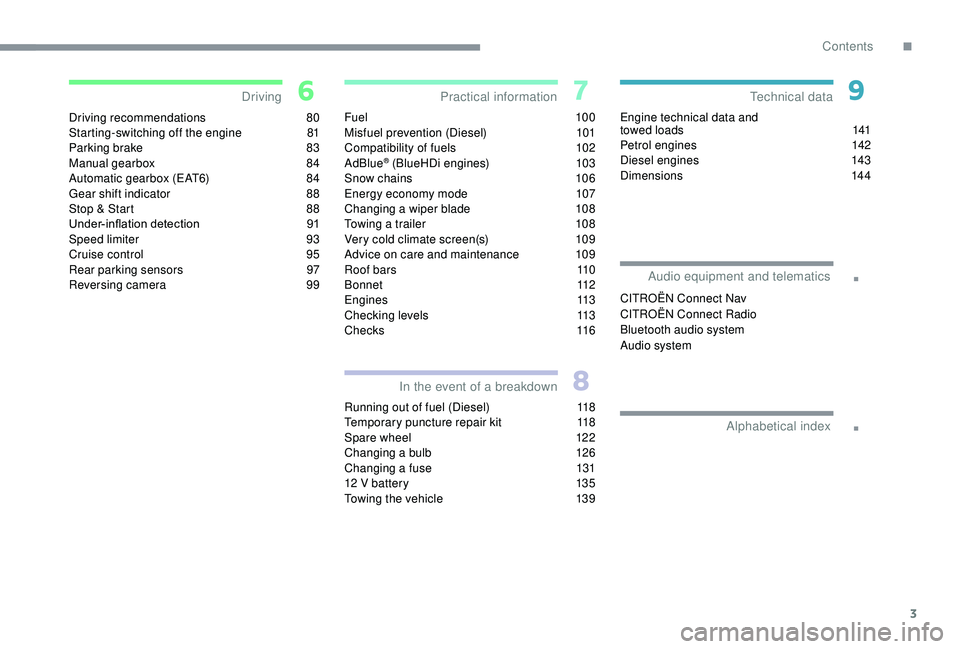
3
.
.
Driving recommendations 80
Starting-switching off the engine 8 1
Parking brake
8
3
Manual gearbox
8
4
Automatic gearbox (EAT6)
8
4
Gear shift indicator
8
8
Stop & Start
8
8
Under-inflation detection
9
1
Speed limiter
9
3
Cruise control
9
5
Rear parking sensors
9
7
Reversing camera
9
9Fuel 1
0 0
Misfuel prevention (Diesel) 1 01
Compatibility of fuels
1
02
AdBlue
® (BlueHDi engines) 1 03
Snow chains 1 06
Energy economy mode
1
07
Changing a wiper blade
1
08
Towing a trailer
1
08
Very cold climate screen(s)
1
09
Advice on care and maintenance
1
09
Roof bars
1
10
B o n n e t
112
Engines
1
13
Checking levels
1
13
C h e c k s
11
6
Running out of fuel (Diesel)
1
18
Temporary puncture repair kit
1
18
Spare wheel
1
22
Changing a bulb
1
26
Changing a fuse
1
31
12
V battery
1
35
Towing the vehicle
1
39Engine technical data and
towed loads
1
41
Petrol engines
1
42
Diesel engines 1 43
Dimensions 144
DrivingPractical information
In the event of a breakdown Technical data
Alphabetical index
Audio equipment and telematics
CITROËN Connect Nav
CITROËN Connect Radio
Bluetooth audio system
Audio system
.
Contents
Page 6 of 260
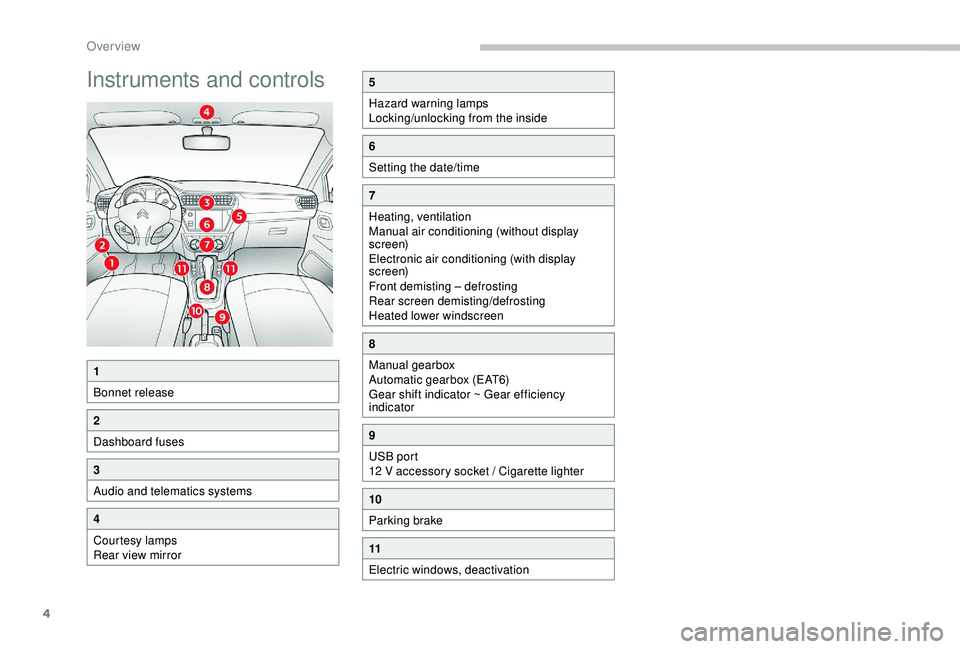
4
Instruments and controls5
Hazard warning lamps
Locking/unlocking from the inside
6
Setting the date/time
7
Heating, ventilation
Manual air conditioning (without display
screen)
Electronic air conditioning (with display
screen)
Front demisting – defrosting
Rear screen demisting/defrosting
Heated lower windscreen
8
Manual gearbox
Automatic gearbox (EAT6)
Gear shift indicator ~ Gear efficiency
indicator
9
USB port
12 V accessory socket / Cigarette lighter
10
Parking brake
11
Electric windows, deactivation
1
Bonnet release
2
Dashboard fuses
3
Audio and telematics systems
4
Courtesy lamps
Rear view mirror
Over view
Page 7 of 260
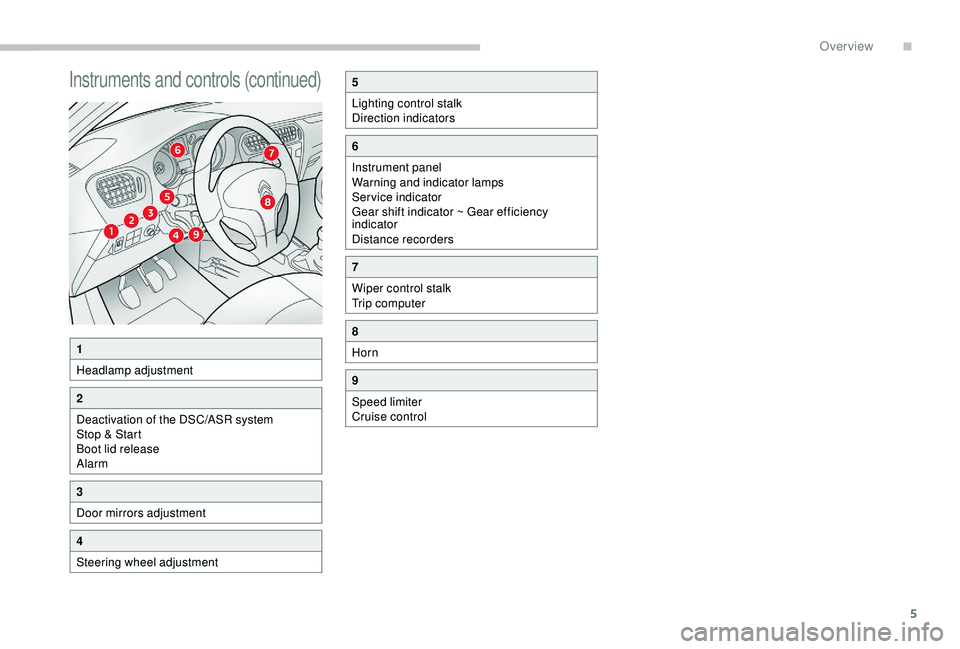
5
Instruments and controls (continued)
1
Headlamp adjustment
2
Deactivation of the DSC/ASR system
Stop & Start
Boot lid release
Alarm
3
Door mirrors adjustment
4
Steering wheel adjustment
5
Lighting control stalk
Direction indicators
6
Instrument panel
Warning and indicator lamps
Service indicator
Gear shift indicator ~ Gear efficiency
indicator
Distance recorders
7
Wiper control stalk
Trip computer
8
Horn
9
Speed limiter
Cruise control
.
Over view
Page 8 of 260
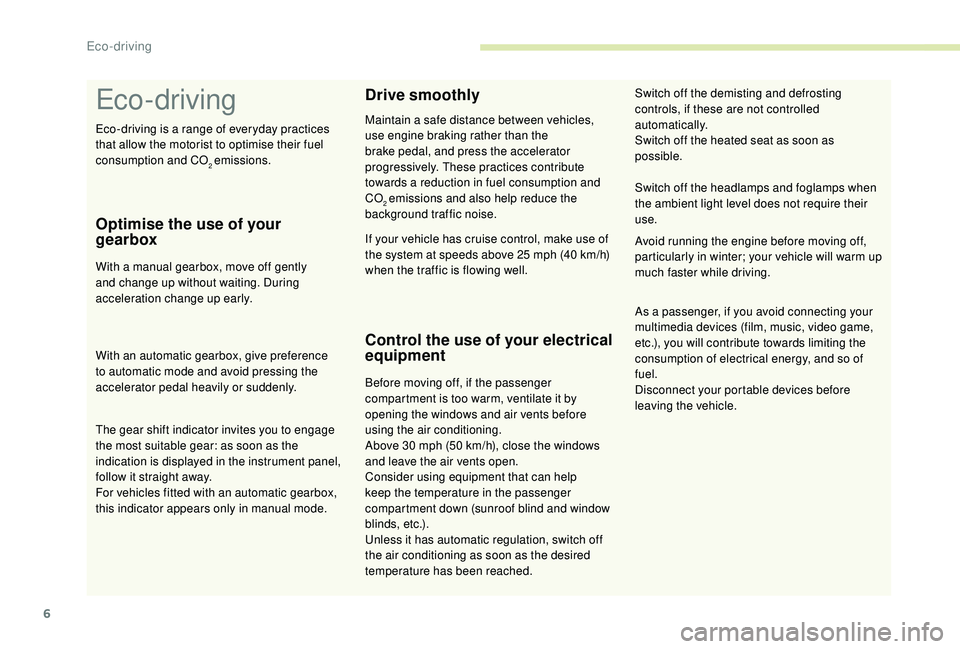
6
Eco- driving
Optimise the use of your
gearbox
With a manual gearbox, move off gently
and change up without waiting. During
acceleration change up early.
With an automatic gearbox, give preference
to automatic mode and avoid pressing the
accelerator pedal heavily or suddenly.
Drive smoothly
Maintain a safe distance between vehicles,
use engine braking rather than the
brake pedal, and press the accelerator
progressively. These practices contribute
towards a reduction in fuel consumption and
CO
2 emissions and also help reduce the
background traffic noise.
Control the use of your electrical
equipment
Before moving off, if the passenger
compartment is too warm, ventilate it by
opening the windows and air vents before
using the air conditioning.
Above 30
mph (50 km/h), close the windows
and leave the air vents open.
Consider using equipment that can help
keep the temperature in the passenger
compartment down (sunroof blind and window
blinds, etc.).
Unless it has automatic regulation, switch off
the air conditioning as soon as the desired
temperature has been reached. Switch off the headlamps and foglamps when
the ambient light level does not require their
use.
Avoid running the engine before moving off,
particularly in winter; your vehicle will warm up
much faster while driving.
As a passenger, if you avoid connecting your
multimedia devices (film, music, video game,
etc.), you will contribute towards limiting the
consumption of electrical energy, and so of
fuel.
Disconnect your portable devices before
leaving the vehicle.
The gear shift indicator invites you to engage
the most suitable gear: as soon as the
indication is displayed in the instrument panel,
follow it straight away.
For vehicles fitted with an automatic gearbox,
this indicator appears only in manual mode. If your vehicle has cruise control, make use of
the system at speeds above 25
mph (40 km/h)
when the traffic is flowing well. Switch off the demisting and defrosting
controls, if these are not controlled
automatically.
Switch off the heated seat as soon as
possible.
Eco-driving is a range of everyday practices
that allow the motorist to optimise their fuel
consumption and CO
2 emissions.
Eco-driving
Page 10 of 260
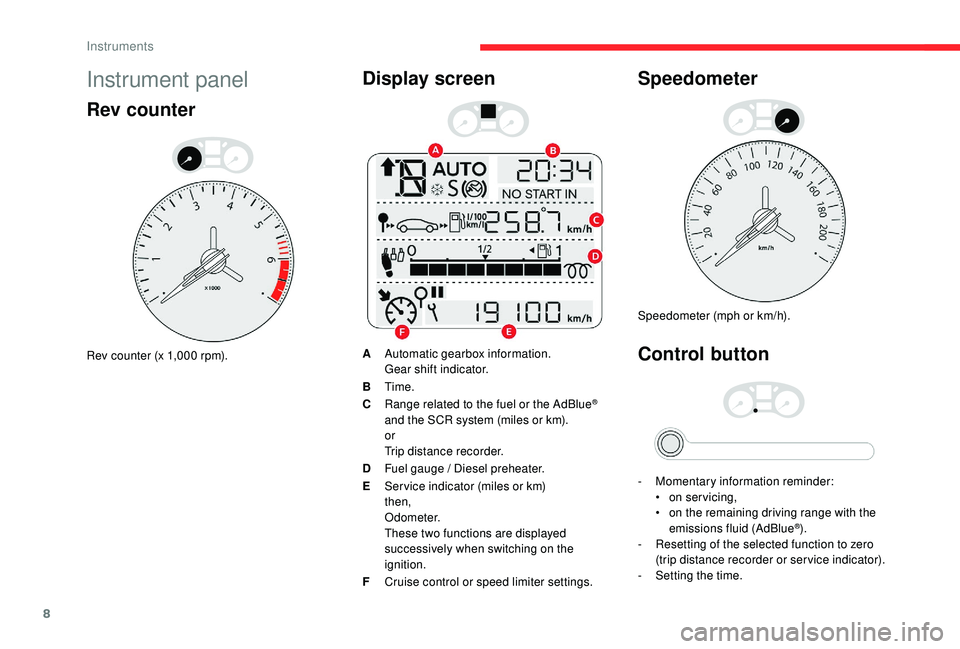
8
Instrument panel
Rev counter
Rev counter (x 1,000 rpm).
Display screen
AAutomatic gearbox information.
Gear shift indicator.
B Time.
C Range related to the fuel or the AdBlue
®
and the SCR system (miles or km).
or
Trip distance recorder.
D Fuel gauge / Diesel preheater.
E Ser vice indicator (miles or km)
then,
Odometer.
These two functions are displayed
successively when switching on the
ignition.
F Cruise control or speed limiter settings.
Speedometer
Speedometer (mph or km/h).
Control button
- Momentary information reminder:
• o n servicing,
•
o
n the remaining driving range with the
emissions fluid (AdBlue
®).
-
R
esetting of the selected function to zero
(trip distance recorder or ser vice indicator).
-
S
etting the time.
Instruments
Page 20 of 260
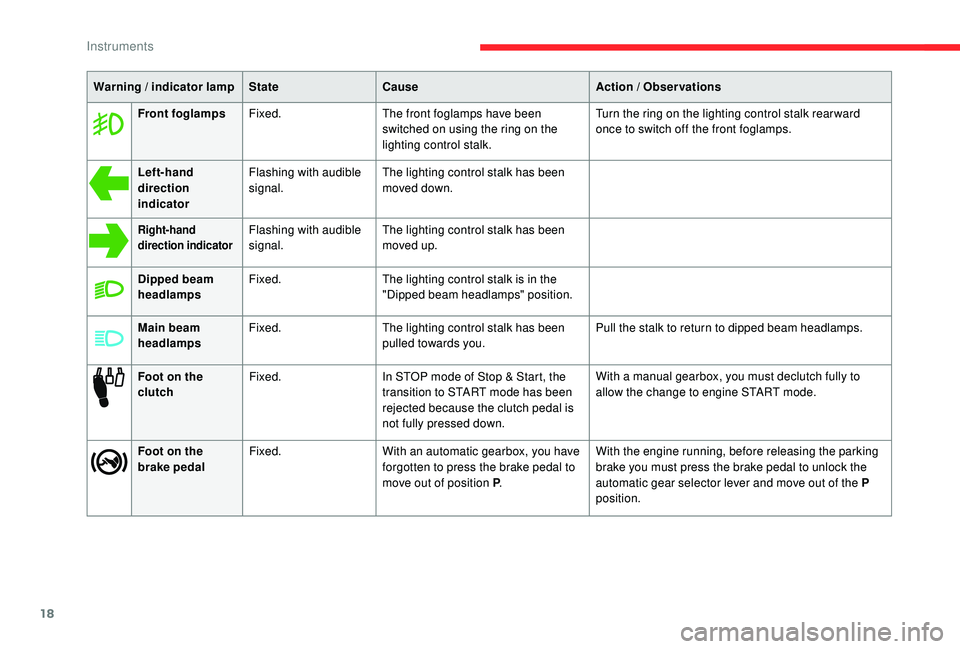
18
Warning / indicator lampStateCause Action / Observations
Front foglamps Fixed. The front foglamps have been
switched on using the ring on the
lighting control stalk. Turn the ring on the lighting control stalk rear ward
once to switch off the front foglamps.
Left-hand
direction
indicator Flashing with audible
signal.
The lighting control stalk has been
moved down.
Right-hand
direction indicatorFlashing with audible
signal.The lighting control stalk has been
moved up.
Dipped beam
headlamps Fixed.
The lighting control stalk is in the
"Dipped beam headlamps" position.
Main beam
headlamps Fixed.
The lighting control stalk has been
pulled towards you. Pull the stalk to return to dipped beam headlamps.
Foot on the
clutch Fixed.
In STOP mode of Stop & Start, the
transition to START mode has been
rejected because the clutch pedal is
not fully pressed down. With a manual gearbox, you must declutch fully to
allow the change to engine START mode.
Foot on the
brake pedal Fixed.
With an automatic gearbox, you have
forgotten to press the brake pedal to
move out of position P.With the engine running, before releasing the parking
brake you must press the brake pedal to unlock the
automatic gear selector lever and move out of the P
position.
Instruments
Page 50 of 260

48
Fittings
Glove box
It can be used to hold a water bottle, the
vehicle's handbook pack, etc.
Depending on version, it may have a lid. In this
case:
F
T
o open the glove box, raise the handle.
Removable ashtray
F Raise the cover to open the ashtray.
F T o empty it, with the cover raised, pull the
ashtray upward.
It contains the front passenger airbag
deactivation switch.
To avoid any problem of inter ference
or risk of overturning, do not place the
ashtray near the gear lever.
Sun visor
Provides protection against sunlight from the
front or the side.
The passenger's sun visor is fitted with a vanity
mirror with concealing flap and a ticket holder.
If after a long period parked in the
sun, the interior temperature is very
high, first ventilate the passenger
compartment for a few moments.
Put the air flow control at a setting high
enough to quickly change the air in the
passenger compartment.
The air conditioning system does not
contain chlorine and does not present
any danger to the ozone layer.
Stop & Star t
The heating and air conditioning systems
only work when the engine is running.
To maintain a comfortable temperature
in the passenger compartment, you can
temporarily deactivate the Stop & Start
system.
For more information on Stop & Star t ,
refer to the corresponding section.
Ease of use and comfort
Page 82 of 260

80
Driving recommendations
Comply with the Highway Code and remain
vigilant whatever the traffic conditions.
Pay close attention to the traffic and keep your
hands on the wheel so that you are ready to
react at any time to any eventuality.
As a safety measure, the driver must only
carry out any operations that require sustained
attention when the vehicle is stationary.
On a long journey, a break every two hours is
strongly recommended.
In bad weather, drive smoothly, anticipate the
need to brake and increase the distance from
other vehicles.
Important!
Never drive with the parking brake applied
– Risk of overheating and damage to the
braking system!
As the exhaust system of your vehicle
is very hot, even several minutes after
switching off the engine, never park or run
the engine on inflammable sur faces (dry
grass, fallen leaves, etc.): Risk of fire!Never leave a vehicle unsuper vised with
the engine running. If you have to leave
your vehicle with the engine running, apply
the parking brake and put the gearbox into
neutral or position N or P
, depending on
the type of gearbox.
Driving on flooded roads
We strongly advise against driving on flooded
roads, as this could cause serious damage
to the engine or gearbox, as well as to the
electrical systems of your vehicle.
If you are obliged to drive through water:
-
c
heck that the depth of water does not
exceed 15
cm, taking account of waves that
might be generated by other users, -
d
eactivate the Stop & Start function,
-
d
rive as slowly as possible without stalling.
Under no circumstances exceed 6 mph
(10 km/h),
-
d
o not stop and do not switch off the engine.
On leaving the flooded road, as soon as
circumstances allow, make several light brake
applications to dry the brake discs and pads.
If in doubt about the state of your vehicle,
contact a CITROËN dealer or a qualified
workshop.
Driving
Page 83 of 260
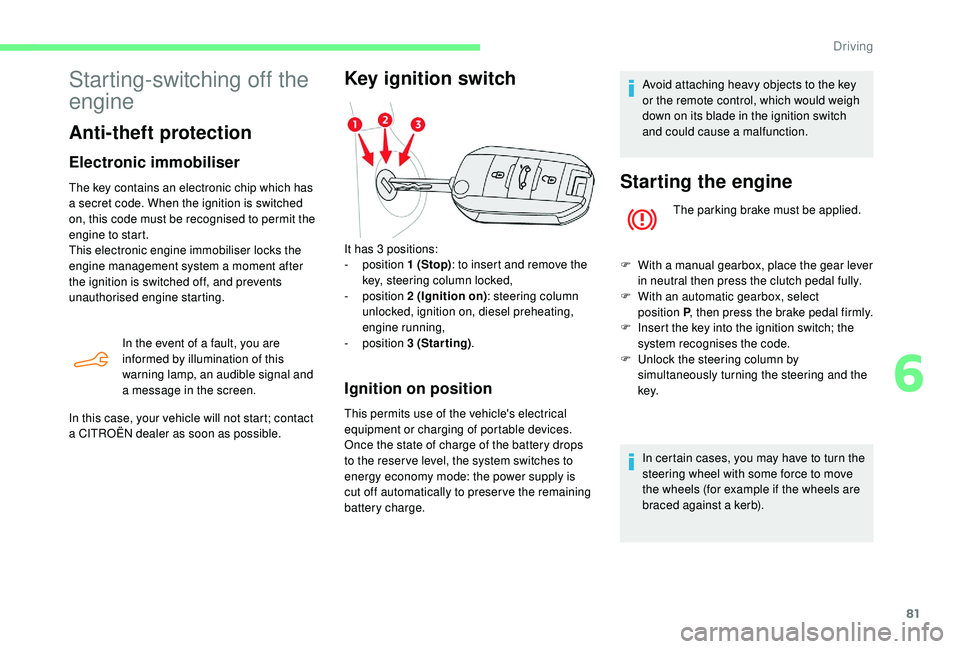
81
Starting-switching off the
engine
Anti-theft protection
Electronic immobiliser
The key contains an electronic chip which has
a secret code. When the ignition is switched
on, this code must be recognised to permit the
engine to start.
This electronic engine immobiliser locks the
engine management system a moment after
the ignition is switched off, and prevents
unauthorised engine starting.In the event of a fault, you are
informed by illumination of this
warning lamp, an audible signal and
a message in the screen.
In this case, your vehicle will not start; contact
a CITROËN dealer as soon as possible.
Key ignition switch
Ignition on position
This permits use of the vehicle's electrical
equipment or charging of portable devices.
Once the state of charge of the battery drops
to the reser ve level, the system switches to
energy economy mode: the power supply is
cut off automatically to preser ve the remaining
battery charge. Avoid attaching heavy objects to the key
or the remote control, which would weigh
down on its blade in the ignition switch
and could cause a malfunction.
Starting the engine
The parking brake must be applied.
F
W
ith a manual gearbox, place the gear lever
in neutral then press the clutch pedal fully.
F
W
ith an automatic gearbox, select
position P , then press the brake pedal firmly.
F
I
nsert the key into the ignition switch; the
system recognises the code.
F
U
nlock the steering column by
simultaneously turning the steering and the
key.
In certain cases, you may have to turn the
steering wheel with some force to move
the wheels (for example if the wheels are
braced against a kerb).
It has 3
positions:
-
position 1
(Stop) : to insert and remove the
key, steering column locked,
-
position 2
(Ignition on) : steering column
unlocked, ignition on, diesel preheating,
engine running,
-
position 3
(Starting) .
6
Driving
Page 84 of 260
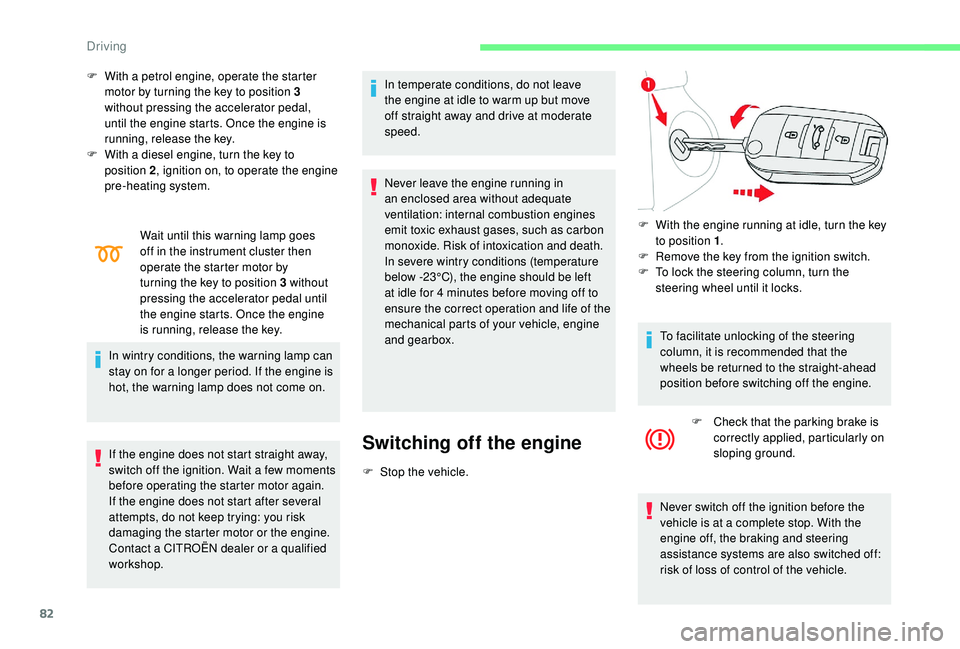
82
F With a petrol engine, operate the starter motor by turning the key to position 3
without pressing the accelerator pedal,
until the engine starts. Once the engine is
running, release the key.
F
W
ith a diesel engine, turn the key to
position 2 , ignition on, to operate the engine
pre-heating system.
Wait until this warning lamp goes
off in the instrument cluster then
operate the starter motor by
turning the key to position 3
without
pressing the accelerator pedal until
the engine starts. Once the engine
is running, release the key.
In wintry conditions, the warning lamp can
stay on for a longer period. If the engine is
hot, the warning lamp does not come on.
If the engine does not start straight away,
switch off the ignition. Wait a few moments
before operating the starter motor again.
If the engine does not start after several
attempts, do not keep trying: you risk
damaging the starter motor or the engine.
Contact a CITROËN dealer or a qualified
workshop. In temperate conditions, do not leave
the engine at idle to warm up but move
off straight away and drive at moderate
speed.
Never leave the engine running in
an enclosed area without adequate
ventilation: internal combustion engines
emit toxic exhaust gases, such as carbon
monoxide. Risk of intoxication and death.
In severe wintry conditions (temperature
below -23°C), the engine should be left
at idle for 4
minutes before moving off to
ensure the correct operation and life of the
mechanical parts of your vehicle, engine
and gearbox.
Switching off the engine
F Stop the vehicle. F
W
ith the engine running at idle, turn the key
to position 1 .
F
R
emove the key from the ignition switch.
F
T
o lock the steering column, turn the
steering wheel until it locks.
To facilitate unlocking of the steering
column, it is recommended that the
wheels be returned to the straight-ahead
position before switching off the engine. F
C
heck that the parking brake is
correctly applied, particularly on
sloping ground.
Never switch off the ignition before the
vehicle is at a complete stop. With the
engine off, the braking and steering
assistance systems are also switched off:
risk of loss of control of the vehicle.
Driving